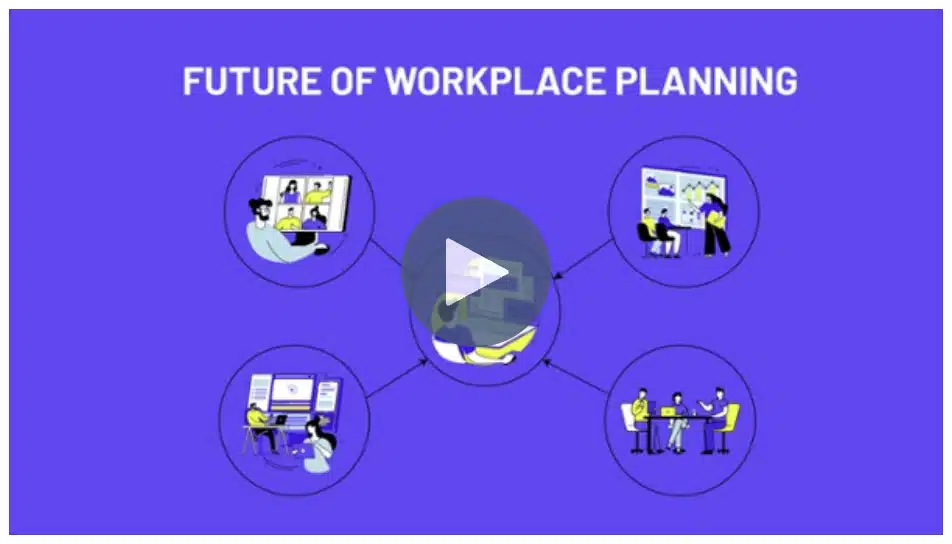Keeping your real estate portfolio relevant requires a lot of data and a renewed mindset focused on collaboration and flexibility.
Owning or renting commercial real estate (CRE) properties, in our evolving and dynamic times, presents unique challenges–especially as workers continue to prefer a more remote-first working environment.
Maintaining a robust, profitable real estate portfolio requires new and intuitive workplace strategies. In the past, with growth came a need for more space but in today’s world of remote/hybrid working, that is not necessarily the case. It was assumed that companies would always own or rent big commercial buildings; however, this assumption is no longer true.
This begs the question:
With millions invested in CRE, what can be done to keep office spaces efficient, updated, profitable, and most of all, relevant to the times?
How to keep offices relevant
Many office spaces are underutilized and inefficient–workspaces often sit empty and a single workspace might get refitted to support many different types of workers over time.
According to findstack.com, 85% of managers believe that having teams work remotely will become the new norm. This shift–while exceptionally disruptive–could be seen as an opportunity to review and change how we utilize office space.
To keep your in-person spaces relevant to evolving worker habits, consider these three points:
1. Occupancy and utilization data
Occupancy and utilization data provide crucial insight into how a space gets used. Once the habits and occupation trends come into clear view, the collected data points paint a picture of the real-life utilization rate of any given space.
 Understanding what is happening in a space can help influence how it will get used and how to design it in the future. For example, a conference room might’ve been built to handle an attendance of 20 people but if on average only five workers use it, there may be a more effective use for that space.
Understanding what is happening in a space can help influence how it will get used and how to design it in the future. For example, a conference room might’ve been built to handle an attendance of 20 people but if on average only five workers use it, there may be a more effective use for that space.
While the average occupancy metric is important, peak occupancy is also key. Many workplaces are experiencing a low average of daily workers and a few days with many workers. In fact, Tuesdays, Wednesdays, and/or Thursdays are becoming the most popular days for office work among workers as many folks want to avoid a commute to start and end the standard work week.
Considering these spikes is crucial when determining how to evolve the design of your workspaces.
Occupancy and utilization data are two key indicators to help identify inefficient space and measured spaces shouldn’t be limited to those where people merely do their work. We should measure foyers, gathering areas like kitchens and break rooms, and collaborative spaces as well. By analyzing this data, decisions about how to adjust the size and function of a particular space–based on actual occupancy and utilization–can and will be a lot easier to make.
2. Collaboration
Individual workspaces like cubicles were largely a thing of the past even before the remote-first revolution. Since the pandemic, the preference to do individual work at home has heightened; however, almost half of employees prefer to collaborate and meet, in-person.
 Excessive individual workspaces prohibit the amount of collaboration that can be done in the office.
Excessive individual workspaces prohibit the amount of collaboration that can be done in the office.
To remedy this, offices are now evolving to include more open floor plans–creating more collaborative spaces that bring departments together which can improve the use of space and promotes more frequent, productive communication.
Having more collaborative spaces brings employees together so they don’t have to waste time setting up endless virtual meetings–collaborative spaces also foster casual collisions and make in-person work more engaging and fulfilling.
For example, imagine you are trying to reduce the occupancy costs or increase how often a space gets used. Putting teams that often work together in close physical proximity has benefits. It can reduce the time spent getting to the spaces and people they interact with the most. If one employee saves one minute a day, that can quickly add up to over 200 minutes a year just for that one person. When you apply that to whole departments of people, the savings become even more apparent.
3. Flexible office spaces
The future of commercial real estate is uncertain and has undoubtedly changed. And while “flexibility” may seem like an overused buzzword, 86% of occupiers said that flexible workspaces are key to their future real estate strategies.
Functionally speaking, to accomplish workplace flexibility, physical spaces must have configurability and multi-purpose, built-in. From easily movable furniture and divider walls, to rolling white boards and an abundance of collaborative nooks–flexible offices have become the norm for companies who have totally rethought their portfolio.
In short, the less “fixed” an office is, the better–we go into this topic quite extensively in this blog post.

Tackling the workplace, in-house
As a result of the abrupt shift away from the office, workplace consultants have emerged to assist with the evolving commercial and office space management challenges. And while these consultants are helpful, they can also be expensive. On top of the cost, having a consultant come in and learn about all that goes on in a certain space takes time.
There are less expensive and quicker ways to assess the current utilization and cost of CRE. New and emerging solutions allow you to see firsthand how your employees are interacting with your space.
Keeping the responsibility of workplace strategy in-house has many benefits. Using monitoring devices and data collection technologies helps create an accurate picture of how your CRE is getting utilized. And having all that data in a centralized place, provides the foundation to support any physical changes to the space.
How Saltmine can help you navigate the future of workplace
In order to keep up with the changes, technology can now monitor and report exactly how often a space is getting utilized and more. These details–including both short- and long-tern budgeting–are essential in determining how to move forward on future real estate plans.
In planning for the future, a flexible solution that can adjust to the needs of your real estate portfolio, can prove most beneficial. Having an in-house, technology-based solution in place provides the necessary framework to support any changes needed in the future.
Saltmine is built to help businesses track and interpret data, cut costs, and empower your team to build better workplaces centered around your most valuable asset–your people.
Whether you are trying to plan for more efficient workspaces in the future or need a solution right away, Saltmine can help you better understand your space needs and plan for design changes in your space. Click the video below to learn more:
Enjoying our blog? Be sure to subscribe to stay up-to-date on Saltmine's original content with the form below!
